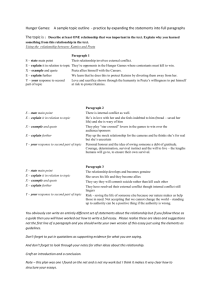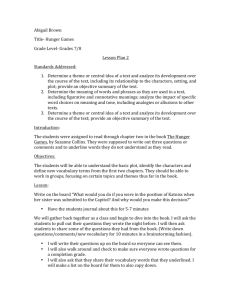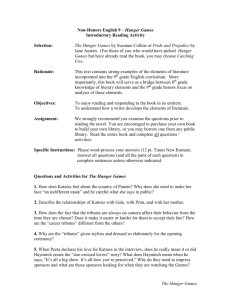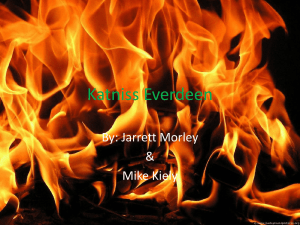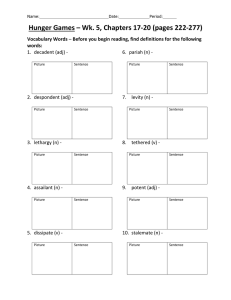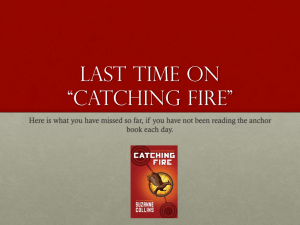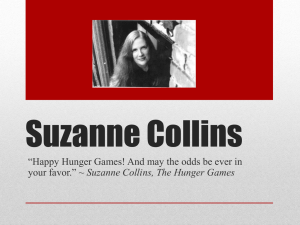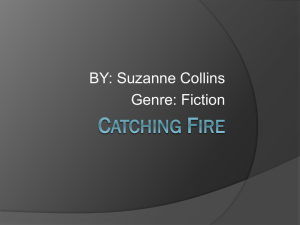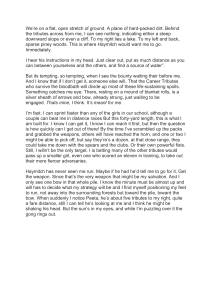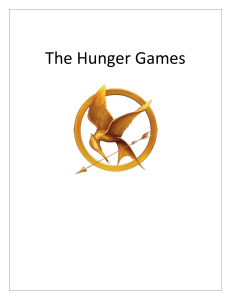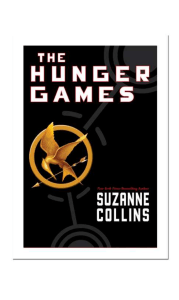The Hunger Games Discussion Questions
advertisement
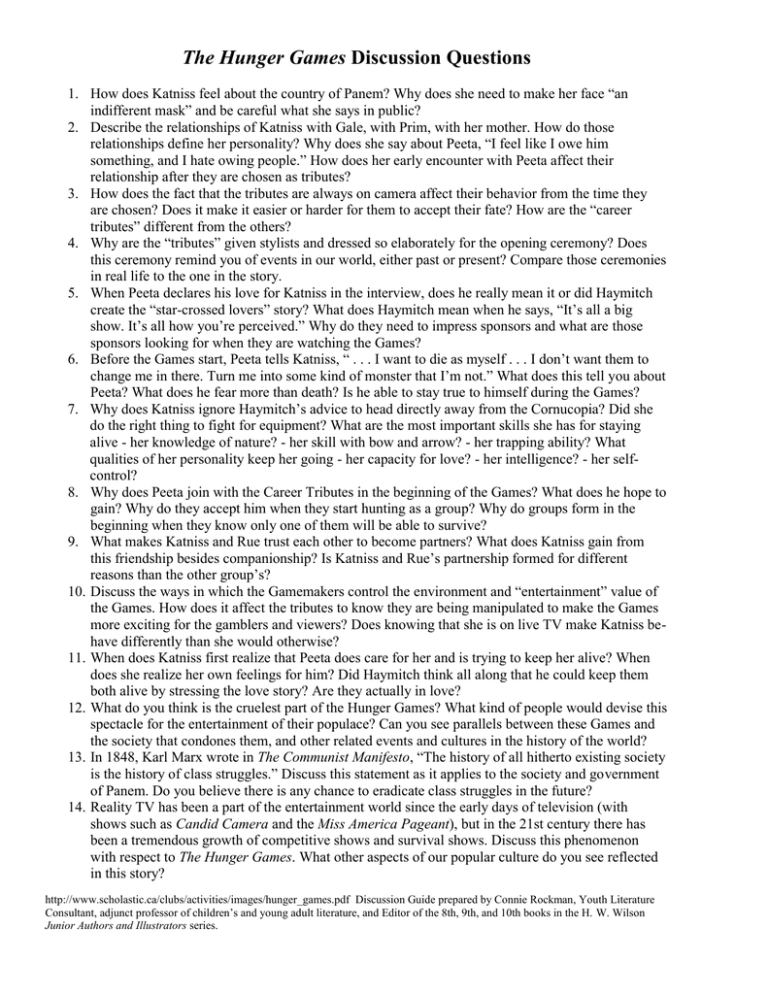
The Hunger Games Discussion Questions 1. How does Katniss feel about the country of Panem? Why does she need to make her face “an indifferent mask” and be careful what she says in public? 2. Describe the relationships of Katniss with Gale, with Prim, with her mother. How do those relationships define her personality? Why does she say about Peeta, “I feel like I owe him something, and I hate owing people.” How does her early encounter with Peeta affect their relationship after they are chosen as tributes? 3. How does the fact that the tributes are always on camera affect their behavior from the time they are chosen? Does it make it easier or harder for them to accept their fate? How are the “career tributes” different from the others? 4. Why are the “tributes” given stylists and dressed so elaborately for the opening ceremony? Does this ceremony remind you of events in our world, either past or present? Compare those ceremonies in real life to the one in the story. 5. When Peeta declares his love for Katniss in the interview, does he really mean it or did Haymitch create the “star-crossed lovers” story? What does Haymitch mean when he says, “It’s all a big show. It’s all how you’re perceived.” Why do they need to impress sponsors and what are those sponsors looking for when they are watching the Games? 6. Before the Games start, Peeta tells Katniss, “ . . . I want to die as myself . . . I don’t want them to change me in there. Turn me into some kind of monster that I’m not.” What does this tell you about Peeta? What does he fear more than death? Is he able to stay true to himself during the Games? 7. Why does Katniss ignore Haymitch’s advice to head directly away from the Cornucopia? Did she do the right thing to fight for equipment? What are the most important skills she has for staying alive - her knowledge of nature? - her skill with bow and arrow? - her trapping ability? What qualities of her personality keep her going - her capacity for love? - her intelligence? - her selfcontrol? 8. Why does Peeta join with the Career Tributes in the beginning of the Games? What does he hope to gain? Why do they accept him when they start hunting as a group? Why do groups form in the beginning when they know only one of them will be able to survive? 9. What makes Katniss and Rue trust each other to become partners? What does Katniss gain from this friendship besides companionship? Is Katniss and Rue’s partnership formed for different reasons than the other group’s? 10. Discuss the ways in which the Gamemakers control the environment and “entertainment” value of the Games. How does it affect the tributes to know they are being manipulated to make the Games more exciting for the gamblers and viewers? Does knowing that she is on live TV make Katniss behave differently than she would otherwise? 11. When does Katniss first realize that Peeta does care for her and is trying to keep her alive? When does she realize her own feelings for him? Did Haymitch think all along that he could keep them both alive by stressing the love story? Are they actually in love? 12. What do you think is the cruelest part of the Hunger Games? What kind of people would devise this spectacle for the entertainment of their populace? Can you see parallels between these Games and the society that condones them, and other related events and cultures in the history of the world? 13. In 1848, Karl Marx wrote in The Communist Manifesto, “The history of all hitherto existing society is the history of class struggles.” Discuss this statement as it applies to the society and government of Panem. Do you believe there is any chance to eradicate class struggles in the future? 14. Reality TV has been a part of the entertainment world since the early days of television (with shows such as Candid Camera and the Miss America Pageant), but in the 21st century there has been a tremendous growth of competitive shows and survival shows. Discuss this phenomenon with respect to The Hunger Games. What other aspects of our popular culture do you see reflected in this story? http://www.scholastic.ca/clubs/activities/images/hunger_games.pdf Discussion Guide prepared by Connie Rockman, Youth Literature Consultant, adjunct professor of children’s and young adult literature, and Editor of the 8th, 9th, and 10th books in the H. W. Wilson Junior Authors and Illustrators series. Suggestions for Further Reading Black Potatoes, by Susan Campbell Bartoletti (Houghton Mifflin, Hunger and starvation during the potato famine of 1845-50 affected the lives of millions in Ireland, while the stratified society of Irish peasants and English overlords contributed to the brutality of the situation. Deep Survival: Who Lives, Who Dies, and Why, by Laurence Gonzales (W. W. Norton, 2004) An exploration of the biological and psychological reasons people risk their lives and why some are better at it than others. GemX, by Nicki Singer (Holiday House, 2008) A future society is divided into the “Enhanced” and the “Natural Born,” both manipulated by a heartless ruler; but love reaches across the society’s barriers and brings hope to a few. Harry Potter and the Goblet of Fire, by J. K. Rowling (Scholastic, 2000) In his fourth year at Hogwarts School, Harry’s name is mysteriously chosen in a lottery to compete in the Triwizard Tournament that pits champions from several schools against each other in a contest of magical skills and endurance. Sunrise Over Fallujah, by Walter Dean Myers (Scholastic, 2008) The actual arena of a war zone in Iraq provides a setting in which present day soldiers must be constantly alert to stay alive while making difficult decisions about who are potential allies and who are their true enemies. The Worst Hard Time, by Timothy Egan (Houghton Mifflin, 2005) Egan relates a chilling chronicle of starvation and hardship during the Dust Bowl years of the 1930s in the American Midwest when economic issues and environmental disasters combined to change the lives of an entire population. The Night Olympic Team: Fighting to Keep Drugs Out of the Games, by Caroline Hatton (Boyds Mills, 2008) Behind the scenes at the 2002 Winter Olympics in Salt Lake City, a team of scientists works through the night to discover the use of performance enhancing drugs in the athletes. Feed, by M. T. Anderson (Candlewick, 2004) In this futuristic society, a “feed” is embedded in the brain of every person to keep up a steady stream of information, entertainment, communication, and ultimately, control. Survival in this world depends on how well your individual “feed” is functioning and how well you fit in with the popular culture. Connect to The Classics The themes and setting of The Hunger Games can be connected for teen readers to many pieces of classic literature that are required reading for high schools. In The Grapes of Wrath, extreme hunger leads ordinary people to seek extraordinary ways to stay alive during the Great Depression. The futuristic novels Brave New World and 1984 both reflect the rigid control and stratified society of the populace that we see in The Hunger Games. The Lord of the Flies is an earlier example of how vicious young people can become, when forced to survive in a wilderness setting. http://www.scholastic.ca/clubs/activities/images/hunger_games.pdf Discussion Guide prepared by Connie Rockman, Youth Literature Consultant, adjunct professor of children’s and young adult literature, and Editor of the 8th, 9th, and 10th books in the H. W. Wilson Junior Authors and Illustrators series. About the Author Suzanne Collins has had a successful and prolific career writing for children’s television. She has worked on the staffs of several Nickelodeon shows, including the Emmy-nominated hit Clarissa Explains it All and The Mystery Files of Shelby Woo. She received a Writer’s Guild of America nomination in animation for co-writing the critically acclaimed Christmas special, Santa, Baby! Suzanne Collins made her mark in children’s literature with the New York Times bestselling series, the Underland Chronicles, for middle grade readers. Her debut novel, Gregor the Overlander, received numerous accolades both in the United States and abroad. Suzanne was inspired to write this series when thinking about Alice in Wonderland. She was struck by how pastoral the setting must seem to todays’ kids who, like her own, lived in urban surroundings. In New York City, you’re much more likely to fall down a manhole than a rabbit hole and, if you do, you’re not going to find a tea party. What you might find...? When eleven-year old Gregor falls through the grating in the floor of his basement laundry room, he finds himself in a world inhabited by giant rats, bats, cockroaches, and spiders. “It’s hard to choose one element that inspired The Hunger Games,” says Suzanne. Probably the first seeds were planted when, as an eight-year-old with a mythology obsession, I read the story of Theseus. The myth told how in punishment for past deeds, Athens periodically had to send seven youths and seven maidens to Crete where they were thrown in the Labyrinth and devoured by the monstrous Minotaur. Even as a third grader, I could appreciate the ruthlessness of this message. ‘Mess with us and we’ll do something worse than kill you. We’ll kill your children.’ Other early influences would have to include watching too many gladiator movies which dramatized the Romans’ flair for turning executions into popular entertainment, my military specialist dad who took us to battlefields for family vacations, and touring with a sword fighting company in high school. But it wasn’t until the much more recent experience of channel surfing between reality TV programming and actual war coverage that the story for this series came to me.” Suzanne Collins lives with her family in Connecticut. http://www.scholastic.ca/clubs/activities/images/hunger_games.pdf Discussion Guide prepared by Connie Rockman, Youth Literature Consultant, adjunct professor of children’s and young adult literature, and Editor of the 8th, 9th, and 10th books in the H. W. Wilson Junior Authors and Illustrators series. The Hunger Games Craft Ideas 1. Design your own tribute costume 2. Tiny bow & arrow The Brooding Hen: Tiny bow & arrow Here is a beautiful little toy that you can make out of things that you probably already have in your house: We have given these as birthday gifts a few times, and they work very well for 4 to 6 year olds. We put them in a special pouch with 6 arrows, and we use fine point pens to decorate the bow with the child's name. They require some practice and fine motor coordination. Contrary to what you saw in that last menacing picture, in our house there is a no-shooting-in-the-direction-of-people-or-pets rule. Take care, they can shoot a surprising 15-20 feet!
